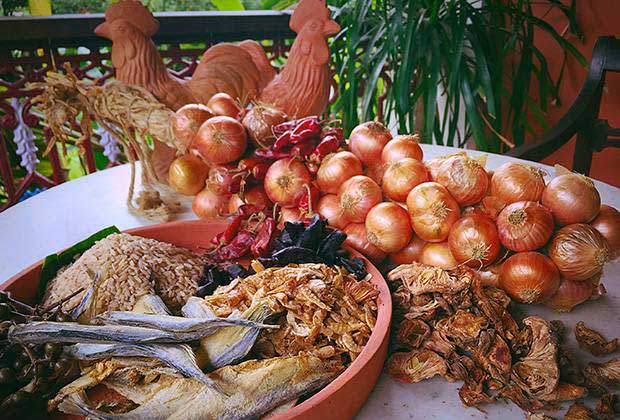What Goa Eats In The Monsoon
- By Shagun MehraLoading...
- | 25 July 2016 12:04 PM GMT
 X
X
 A variety of dried fish compensates for fresh seafood in Goa. Photo: Shagun Mehra
A variety of dried fish compensates for fresh seafood in Goa. Photo: Shagun Mehra
The stifling heat of the sticky tropical summer in Goa was at its sweltering peak. The heavy humid air, left the usually vibrant village lanes deserted, as most people succumbed to long afternoon siestas. The thought of the ensuing monsoon showers remained an intangible, almost surreal, dream.
And then suddenly one day it arrived, in all its glory with bellowing downpours that made the landscapes of Goa glisten. From the towering coconut trees to the fanning palms, the entire tropical flora became a kaleidoscope of lush greens. Monsoons in Goa may be termed as ‘off-season’, but the reality is that Goa is never more exquisite than it is during the rains.
The monsoon fair
The food culture of Goa during this time of the year is quite distinctive to most other parts of the country. The rains can be torrential and unforgiving. In olden times, transport wasn’t quite as sophisticated nor was there a possibility of buying foods from supermarkets.
The usually energetic local markets are now sprinkled with a few brave and despondent mongers. It was a feat to leave home and try and find fresh produce outside. Hence, the Goans prepared their pantries to withstand the severest rainy days much in advance.
Before the monsoons hit the Goan shores, each year as a matter of tradition, a fair is held. This is a special monsoon food fare where farmers and home cooks display and sell all the quintessential goodies for the rainy days to come. These include dried kokum (Indian mangosteen and also a souring agent), dried tamarind, pickles, papads and monsoon greens like the Goan Purple Spinach and all sorts of gourds.
There are preparations in the home kitchens too. The ladies make pickles from various vegetables, meats and seafood using whole and ground spices, palm vinegar and oil.
Luck by chance
The Fishing Department of Goa has put a ban on fishing during the monsoons. They are conscious about overfishing and hence the huge fishing trawlers are debarred from entering the high seas. It’s important for the fish to spawn in order for the preservation of the various species. But, it is almost inexplicable to imagine Goan food without seafood.
To salvage this calamitous situation, the Fisheries Department has come up with seven mobile fish vans, which supply fresh seafood through the monsoons. These come from boats that validly go fishing and the quantity of fish on board is controlled. These vans carry an array of fish like King Fish, Snappers, Prawns and other fresh catch of the day.
Hello, dried fish!
Outside of this, the fervent fish addicts will find estuarine fish and crustaceans, which are very delicate to taste but frightfully expensive. The best option to revelling in the taste of the sea during the rains is to cook with dried fish. There is a special array in the market place, where dried fish sell like hot cakes. These stands reek of the robust smells coming from sun-dried shrimps, mackerels and other fish. These are the busiest stalls at this time of year with lots of smiling chatter and affable haggling.
Once the rains arrive, the market scene changes dramatically. Even the fish market, which otherwise needs nudging around to find room, is dotted by a few backwater fishing ladies with clams, prawns and some fish that their husbands have caught on the fishing line over the many Goan bridges.
Sting ray pickles, anyone?
Most of the popular restaurants are closed during this season and eating out doesn’t encourage a wide menu spread. But for one visiting during the rains, it is best to go with whatever is freshly available. This is usually at the discretion of the food carts and restaurants. One can sometimes find interesting pickles made from stingray, octopus and white bait to take home to invigorate the rainy Goan memories.
What to eat
Goa during the monsoons is a harbour of verdant green tropical flora. From the flooded paddy fields to the ferocious waves on the beaches, Goa is at its dramatic best. Try a fragrant dry shrimp ‘Kismur’ with sol kadi and rice or drench your warm poee in a comforting Ros Omelette. Goa will never disenchant.
Where to eat
Saunter into Cafe Real, Tato or Cafe Bhonsle in Panjim to taste traditional vegetarian fare. The food is fresh and seasonal and one mustn’t miss the aloo chi bhaaji - my absolute favourite. To enjoy spicy mutton and beef, venture to the bustling centre of Mapusa and ask anyone for Ashok Bar. Watch the rain coming down with a beer in one hand and a warm pau in the other for the perfect monsoon munchies.
The author studied Hotel Management at Ecole Les Roches in Switzerland followed by a stint at Le Cordon Bleu, Paris. She is also a wine connoisseur and completed her Advanced Wine Studies from WSET, UK.




